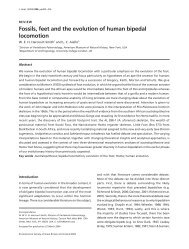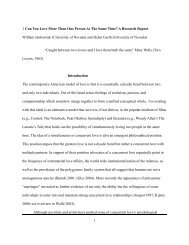Why do humans reason? Arguments for an argumentative theory
Why do humans reason? Arguments for an argumentative theory
Why do humans reason? Arguments for an argumentative theory
Create successful ePaper yourself
Turn your PDF publications into a flip-book with our unique Google optimized e-Paper software.
Mercier & Sperber: <strong>Why</strong> <strong>do</strong> <strong>hum<strong>an</strong>s</strong> <strong>reason</strong>?passed, <strong>an</strong>d they could now be in my jacket, <strong>for</strong> example.However, unless I have some positive <strong>reason</strong> to think otherwise,I just assume that they are still in my trousers, <strong>an</strong>dI <strong>do</strong>n’t even make the inference (which, if I am right,would be valid) that they are not in my jacket or <strong>an</strong>y ofthe other places where, in principle, they might be. Insuch cases, people typically draw positive rather th<strong>an</strong> negativeinferences from their previous beliefs. These positiveinferences are generally more relev<strong>an</strong>t to testing thesebeliefs. For inst<strong>an</strong>ce, I am more likely to get conclusive evidencethat I was right or wrong by looking <strong>for</strong> my keys inmy trousers rather th<strong>an</strong> in my jacket (even if they turnout not to be in my jacket, I might still be wrong in thinkingthat they are in my trousers). We spont<strong>an</strong>eously derivepositive consequences from our intuitive beliefs. This isjust a trusting use of our beliefs, not a confirmation bias(see Klaym<strong>an</strong> & Ha 1987).The <strong>theory</strong> we are proposing makes three broad predictions.The first is that the genuine confirmation bias (asopposed to straight<strong>for</strong>ward trust in one’s intuitive beliefs<strong>an</strong>d their positive consequences) should occur only in<strong>argumentative</strong> situations. The second is that it shoul<strong>do</strong>ccur only in the production of arguments. The rationale<strong>for</strong> a confirmation bias in the production of arguments tosupport a given claim <strong>do</strong>es not extend to the evaluationof arguments by <strong>an</strong> audience that is just aiming to bewell in<strong>for</strong>med. The third prediction is that the confirmationbias in the production of arguments is not a biasin favor of confirmation in general <strong>an</strong>d against disconfirmationin general: It is a bias in favor of confirmingone’s own claims, which should be naturally complementedby a bias in favor of disconfirming opposing claims<strong>an</strong>d counterarguments.3.1. Hypothesis testing: No <strong>reason</strong>ing, no <strong>reason</strong>ingbiasOne of the areas in which the confirmation bias has beenmost thoroughly studied is that of hypothesis testing, oftenusing Wason’s rule discovery task (Wason 1960). In thistask, particip<strong>an</strong>ts are told that the experimenter has inmind a rule <strong>for</strong> generating number triples <strong>an</strong>d that theyhave to discover it. The experimenter starts by giving particip<strong>an</strong>tsa triple that con<strong>for</strong>ms to the rule (2, 4, 6). Particip<strong>an</strong>tsc<strong>an</strong> then think of a hypothesis about the rule <strong>an</strong>d testit by proposing a triple of their own choice. The experimentersays whether or not this triple con<strong>for</strong>ms to therule. Particip<strong>an</strong>ts c<strong>an</strong> repeat the procedure until theyfeel ready to put <strong>for</strong>ward their hypothesis about the rule.The experimenter tells them whether or not their hypothesisis true. If it is not, they c<strong>an</strong> try again or give up.Particip<strong>an</strong>ts overwhelmingly propose triples that fit withthe hypothesis they have in mind. For inst<strong>an</strong>ce, if a particip<strong>an</strong>thas <strong>for</strong>med the hypothesis “three even numbers inascending order,” she might try 8, 10, 12. As argued byKlaym<strong>an</strong> <strong>an</strong>d Ha (1987), such <strong>an</strong> <strong>an</strong>swer corresponds toa “positive test strategy” of a type that would be quiteeffective in most cases. This strategy is not a<strong>do</strong>pted in areflective m<strong>an</strong>ner, but is rather, we suggest, the intuitiveway to exploit one’s intuitive hypotheses, as when wecheck that our keys are where we believe we left themas opposed to checking that they are not where it followsfrom our belief that they should not be. What we seehere, then, is a sound heuristic rather th<strong>an</strong> a bias.This heuristic misleads particip<strong>an</strong>ts in this case onlybecause of some very peculiar (<strong>an</strong>d expressly designed)features of the task. What is really striking is the failureof attempts to get particip<strong>an</strong>ts to <strong>reason</strong> in order tocorrect their ineffective approach. It has been shownthat, even when instructed to try to falsify the hypothesesthey generate, fewer th<strong>an</strong> one particip<strong>an</strong>t in ten is able to<strong>do</strong> so (Poletiek 1996; Tweney et al. 1980). Since thehypotheses are generated by the particip<strong>an</strong>ts themselves,this is what we should expect in the current framework:The situation is not <strong>an</strong> <strong>argumentative</strong> one <strong>an</strong>d <strong>do</strong>es notactivate <strong>reason</strong>ing. However, if a hypothesis is presentedas coming from someone else, it seems that more particip<strong>an</strong>tswill try to falsify it <strong>an</strong>d will give it up much morereadily in favor of <strong>an</strong>other hypothesis (Cowley & Byrne2005). The same applies if the hypothesis is generatedby a minority member in a group setting (Butera et al.1992). Thus, falsification is accessible provided that thesituation encourages particip<strong>an</strong>ts to argue against ahypothesis that is not their own.3.2. The Wason selection taskA similar interpretation c<strong>an</strong> be used to account <strong>for</strong> resultsobtained with the Wason selection task (Wason 1966). Inthis task, particip<strong>an</strong>ts are given a rule describing fourcards. In the original version, the cards have a numberon one side <strong>an</strong>d a letter on the other, although only oneside is visible – they might see, <strong>for</strong> inst<strong>an</strong>ce, 4, E, 7, <strong>an</strong>dK. The rule might read, “If there is a vowel on one side,then there is <strong>an</strong> even number on the other side.” Thetask is to say what cards need to be turned over to determinewhether the rule is true. In this task, too, it isuseful to distinguish the effects of intuitive mech<strong>an</strong>ismsfrom those of <strong>reason</strong>ing proper (as has long beensuggested by Wason & Ev<strong>an</strong>s 1975). Intuitive mech<strong>an</strong>ismsinvolved in underst<strong>an</strong>ding utter<strong>an</strong>ces will draw the particip<strong>an</strong>ts’attention to the cards that are made most relev<strong>an</strong>tby the rule <strong>an</strong>d the context (Girotto et al. 2001; Sperberet al. 1995). In the st<strong>an</strong>dard case, these will simply bethe cards mentioned in the rule (the vowel E <strong>an</strong>d theeven number 4), as opposed to those that would yieldthe correct <strong>an</strong>swer (the E <strong>an</strong>d the 7). Given that the 4c<strong>an</strong> only confirm the rule but not falsify it, the behaviorof particip<strong>an</strong>ts who select this card could be interpretedas showing a confirmation bias. However, as first discoveredby Ev<strong>an</strong>s (Ev<strong>an</strong>s & Lynch 1973), the simple additionof a negation in the rule (“if there is a vowel on one side,then there is not <strong>an</strong> even number on the other side”)leaves the <strong>an</strong>swers unch<strong>an</strong>ged (the E <strong>an</strong>d 4 are stillmade relev<strong>an</strong>t), but in this case these cards correspondto the correct, falsifying, response. So these intuitivemech<strong>an</strong>isms are not intrinsically linked to either confirmationor falsification: They just happen to point tocards that in some cases might confirm the rule <strong>an</strong>d, inother cases, might falsify it.Confirmation bias <strong>do</strong>es occur in the selection task but at<strong>an</strong>other level. Once the particip<strong>an</strong>ts’ attention has beendrawn to some of the cards, <strong>an</strong>d they have arrived at <strong>an</strong>intuitive <strong>an</strong>swer to the question, <strong>reason</strong>ing is used not toevaluate <strong>an</strong>d correct their initial intuition but to find justifications<strong>for</strong> it (Ev<strong>an</strong>s 1996; Lucas & Ball 2005; Roberts &Newton 2001). This is a genuine confirmation bias. As withhypothesis testing, this <strong>do</strong>es not me<strong>an</strong> that particip<strong>an</strong>ts are64 BEHAVIORAL AND BRAIN SCIENCES (2011) 34:2




